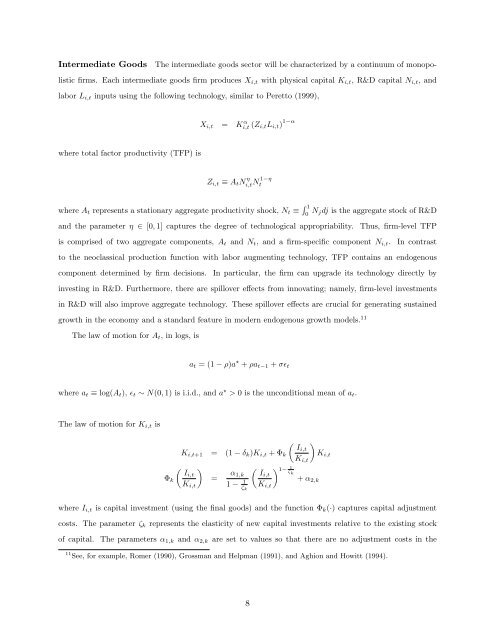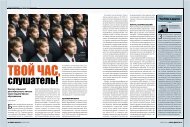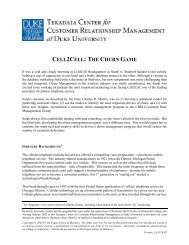Equilibrium Growth, Inflation, and Bond Yields - Duke University's ...
Equilibrium Growth, Inflation, and Bond Yields - Duke University's ...
Equilibrium Growth, Inflation, and Bond Yields - Duke University's ...
Create successful ePaper yourself
Turn your PDF publications into a flip-book with our unique Google optimized e-Paper software.
Intermediate Goods The intermediate goods sector will be characterized by a continuum of monopo-<br />
listic firms. Each intermediate goods firm produces Xi,t with physical capital Ki,t, R&D capital Ni,t, <strong>and</strong><br />
labor Li,t inputs using the following technology, similar to Peretto (1999),<br />
where total factor productivity (TFP) is<br />
Xi,t = K α i,t (Zi,tLi,t) 1−α<br />
Zi,t ≡ AtN η 1−η<br />
i,tNt where At represents a stationary aggregate productivity shock, Nt ≡ � 1<br />
0 Njdj is the aggregate stock of R&D<br />
<strong>and</strong> the parameter η ∈ [0, 1] captures the degree of technological appropriability. Thus, firm-level TFP<br />
is comprised of two aggregate components, At <strong>and</strong> Nt, <strong>and</strong> a firm-specific component Ni,t. In contrast<br />
to the neoclassical production function with labor augmenting technology, TFP contains an endogenous<br />
component determined by firm decisions. In particular, the firm can upgrade its technology directly by<br />
investing in R&D. Furthermore, there are spillover effects from innovating; namely, firm-level investments<br />
in R&D will also improve aggregate technology. These spillover effects are crucial for generating sustained<br />
growth in the economy <strong>and</strong> a st<strong>and</strong>ard feature in modern endogenous growth models. 11<br />
The law of motion for At, in logs, is<br />
at = (1 − ρ)a ⋆ + ρat−1 + σɛt<br />
where at ≡ log(At), ɛt ∼ N(0, 1) is i.i.d., <strong>and</strong> a ⋆ > 0 is the unconditional mean of at.<br />
The law of motion for Ki,t is<br />
�<br />
Ii,t<br />
Ki,t+1 = (1 − δk)Ki,t + Φk Ki,t<br />
Ki,t<br />
� �<br />
� � 1 1− ζ<br />
Ii,t<br />
Ii,t<br />
k<br />
Φk =<br />
+ α2,k<br />
Ki,t<br />
Ki,t<br />
α1,k<br />
1 − 1<br />
ζk<br />
where Ii,t is capital investment (using the final goods) <strong>and</strong> the function Φk(·) captures capital adjustment<br />
costs. The parameter ζk represents the elasticity of new capital investments relative to the existing stock<br />
of capital. The parameters α1,k <strong>and</strong> α2,k are set to values so that there are no adjustment costs in the<br />
11 See, for example, Romer (1990), Grossman <strong>and</strong> Helpman (1991), <strong>and</strong> Aghion <strong>and</strong> Howitt (1994).<br />
8<br />
�
















